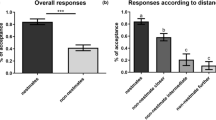Abstract
The mechanism by which female Xylocopa pubescenslocate their nest in a nesting aggregation was investigated. The bees were induced to nest in canes to which uniform nest entrances were attached. The results of nest displacement experiments revealed that the bees use visual cues for proximate orientation,but at very close range they also use olfactory cues. This conclusion was corroborated by the results of experiments in which the nest entrances were either removed or exchanged for alien nest entrances. Moreover, habituation experiments strongly indicated that the bees impart their individual marking at the nest entrance and that they can learn and memorize the individual odors of the neighboring bees.
Similar content being viewed by others
References
Anzenberger, G. (1986). How do carpenter bees recognize the entrance of their nests? An experimental investigation in a natural habitat.Ethology 71: 54–62.
Ayasse, M. (1990). Odor based interindividual and nest recognition in the sweat beeLasioglossum malachurum (Hymenoptera: Halictidae). In Veeresh, G. K., Malik, B., and Viraktamath, C. A. (eds.),Social Insects and Their Environment, Proc. 11th Int. Congr. IUSSI, pp. 511–512.
Butler, C. G., Fletcher, D. J. C., and Watler, D. (1969). Nest entrance marking with pheromones by the honeybeeApis mellifera L., and by a wasp,Vespula vulgaris L.Anim. Behav. 17: 142–147.
Espelie, K. E., Wenzel, J. W., and Chang, G. (1990). Surface lipids of social waspPolistes metricus Say and its nest and nest pedicel and their relation to nestmate recognition.J. Chem. Ecol. 16: 2229–2241.
Evans, H. E., and Eberhard, M. J. W. (1970).The Wasps, University of Michigan Press, Ann Arbor.
Foster, R. L., and Gamboa, G. J. (1989). Nest entrance marking with colony specific odors by the bumble beeBombus occidentalis (Hymenoptera: Apidae).Ethology 81: 273–278.
Hefetz, A. (1990). Individual badges and specific messages in multicomponent pheromones of bees (Hymenoptera: Apidae).Entomol. Gen. 15: 103–113.
Hefetz, A., Mevoreh, D., and Gerling, D. (1990). Nest recognition by scent in the carpenter beeXylocopa pubescens. In Veeresh, G. K., Malik, B., and Viraktamath, C. A. (eds.),Social Insects and Their Environment, Proc. 11th Int. Congr. IUSSI, pp. 515–516.
Kukuk, P. F., Breed, M. D., Sobti, A., and Bell, W. J. (1977). The contributions of kinship and conditioning to nest recognition and colony member recognition in a primitively eusocial bee,Lasioglossum zephyrum (Hymenoptera: Halictidae).Behav. Ecol. Sociobiol. 2: 319–327.
Shimron, O., Hefetz, A., and Tengo, J. (1985). Structural and communicative functions of Dufour's gland secretion inEucera palestinae (Hymenoptera: Anthophoridae).Insect Biochem. 15: 635–638.
Steinmann, E. (1976). Uber die Nahorientierung solitarer Hymenopteren: Individuelle Markierung der Nesteingange.Bull. Soc. Entomol. Suisse 49: 253–258.
Steinmann, E. (1981). On short-range orientation of solitary Hymenoptera: Choice experiments with entrance marks.Bull. Soc. Entomol. 54: 215–220.
Tinbergen, N. (1972).The Animal and Its World: Exploration of an Ethologist 1932–1972, Vol. 1. Field Studies, Harvard University Press, Cambridge, Mass.
Author information
Authors and Affiliations
Rights and permissions
About this article
Cite this article
Hefetz, A. Individual scent marking of the nest entrance as a mechanism for nest recognition inXylocopa pubescens (Hymenoptera: Anthophoridae). J Insect Behav 5, 763–772 (1992). https://doi.org/10.1007/BF01047985
Accepted:
Issue Date:
DOI: https://doi.org/10.1007/BF01047985




